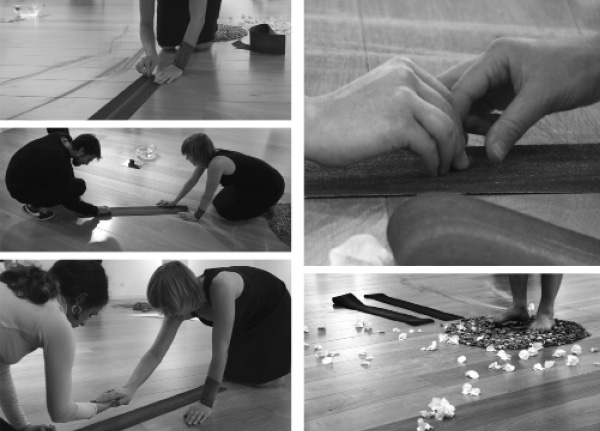
TONE DOWN THE EDGE OF AN ITCHY STONE
first performed on November 25, 2017
Loukia & Michael Zampelas Art Museum, Nicosia, Cyprus
performed once in 2017
LIESJE VAN DEN BERK
Amsterdam, Netherlands
094973813l094973813i094973813e094973813s094973813j094973813e094973813@094973813l094973813i094973813e094973813s094973813j094973813e094973813b094973813e094973813r094973813k094973813.094973813n094973813l
liesjeberk.nl
TONE DOWN THE EDGE OF AN ITCHY STONE
LIESJE VAN DEN BERK
“Tone down the edge of an itchy stone”
Duration: 3 hours
Materials: Gravel and stones from the buffer zone between Greek and Turkish Cyprus in Kaimakli (an urban area of Nicosia); sandpaper; bougainvillea flowers
During my performance-based research on the buffer zone between Greek and Turkish Cyprus, I used my sense of touch to collect empirical data. Using my body and various other materials (gravel, stones, and flowers), I transcend the intimate discomfort of the historically divided area of conflict. The performance resonates with the tactility, segregation, and emotional space around the buffer zone of Kaimakli.
The gravel and stones itched under my feet and the wind blew in all directions without any borders turning everything around. For the performance, I placed the gravel and stones in a circle inside the museum and used them as marking objects. I laid white bougainvillea flowers from the garden and a line of sandpaper around the circle.
When the audience entered the museum, I stood in the middle of the room on the stones and the audience walked around me. I laid the line of sandpaper in front of the feet of the audience and started drawing and sanding with a stone in a straight line, to soften the edges. A spectator joined at the other end of the sandpaper and we created together an ongoing movement to shape a line. The repetitive rhythm of a scratching stone echoed in the museum, a dialogue without words.
The stones were filed to dust but also became refined gems. The sanding created both friction and soft warmth; this energy was shared with the audience by holding it together in each other’s hands. After the stone was smoothed I placed it back in the circle under my feet. I repeated this action with another stone. Traces of dust lines were spread on the floor as a memory of the conflict, dialogue, and the demarcation.
In between, I picked up a flower and looked at how it moved by itself in the space. For a moment the dead flower was alive, a presence in the space. The flower blew away like the wind changing the borderline, a view from another side.